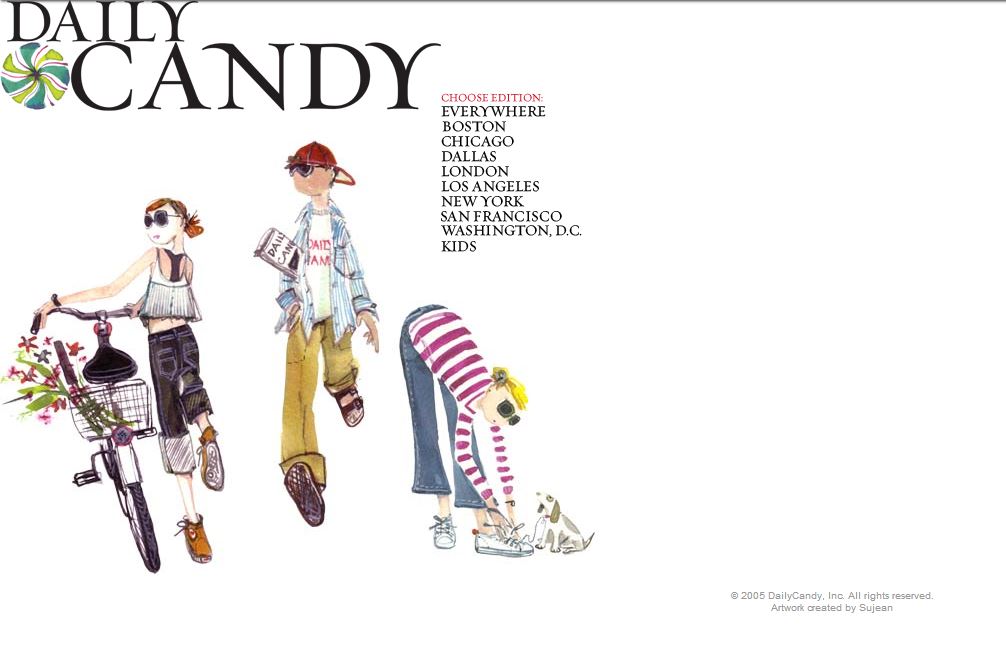Today it was announced that the women’s lifestyle and fashion site that started it all, DailyCandy, is going down. And not in a blaze of glory. But in a what appears to have been a slow burn (with a few sporadic hot spots) since the site was purchased in 2008 by the Comcast media unit for $125 million from New York-based Pilot Group.
Based on the above summary, it makes sense that NBCU hired well-regarded digital exec Alison Moore (previously at HBO) in late 2012 about the time the site traffic was trending down. Moore was tasked with engaging and growing the site’s user base of 6 million by increasing DC’s efforts on a range of platforms– especially their video offerings (a must for all lifestyle sites), while attempting various multiplatform programming partnerships with NBCU’s many television and digital assets. In short: NBCU wanted DailyCandy to use all their shows and clips on the site. But even Moore’s expertise couldn’t moor the sinking site.
So how could a site with so much potential, and so much invested, go under? A site that to all outside eyes looked incredibly successful.
If we take a trip down DailyCandy memory lane, the homepage today is a far cry from the site’s origins as a local recommendations site. Their go here, shop there, eat this vibe. The site was stocked with simple tips and pleasures for women who had the leisure and the disposable income to make certain “tips” and trips, reality.
This is what DailyCandy looked like on Dec 13, 2001.
By 2005, the site was still unfettered. The Internet had yet to see the boom of fashion bloggers, and the pressure to be an end-all-be-all site was still an arm’s length away. This was around the time when everyone was still making jest of the fact that Oprah put herself on every.single.cover of O (it’s possible she started this whole selfie mess), and no successful site assumed that those fashion blogger sites would be the next best, big thing. Readers still opted for unique articles over pretty pictures. And most scoffed at blogs full of selfies and girls posting photos of themselves and calling it editing.
But despite the scoffing, the rise of fashion bloggers happened. And the rather repetitive nature of their sites should have indicated to companies like DailyCandy that sometimes less means more. More unique readers. More followers. More of an opportunity to make more money and, ultimately stay in business.
To illustrate this point, earlier this year, the Consumer Reports National Research Center conducted a survey that, once and for all, confirmed what people have always had a sneaking suspicion of: too much of a good thing isn’t always, well, a good thing. While some people are capable of browsing for hours, most have objectives when they walk into their supermarket (or superhighway). That’s where the problem lies: when confronted with a plethora of options, like twenty-five choices of Lady Speedstick with different scents and different functions, a simple task becomes overwhelming. (Remember psychologist Barry Schwartz’s TED Talk on ‘The Paradox of Choice?‘)
The Consumer Reports study revealed that an “abundance of choice” can actually complicate the decision-making process, leaving consumers anxious about the decision they’re making and even dissatisfied with their choice after they’ve made it. And sometimes, it becomes so complicated that they won’t make it all – 5% of consumers interviewed confessed that they’ve left stores empty-handed because it was all just too much. Now replace “stores” with “lifestyle blogs,” and you get the picture we’re trying to paint.
Blogs that become websites like DailyCandy are basically digital versions of Target: they assault us with an explosion of unrelated content, scrollbars longer than our arms and more drop-downs than hip-hop music videos. They become increasingly harder to navigate, and discovering that one article which feels like it was written for us amid all the content that we just don’t care about becomes a Herculean task, easy to give up altogether.
Why would we subject ourselves to that torture when we can walk down the digital street to the mom-and-pop blog that has less but more focused choices, where the scope is specific, and where the content feels like it was created just for us?
The more DailyCandy added, reading it felt more and more like a chore– say, unloading the dishwasher night after night, when you just want to go to sleep. And readers began to turn to sites where they felt less inundated by product and review and all of Moore’s directives. DailyCandy was no longer Daily; it was MinuteCandy, HourCandy, driven by what most probably assumed was a ravenous readership. And it was no longer just Candy–it was Kale, and Cashmere, and Karma, and posts about the Post Office. And despite its initial successes, which were impressive and adored, DailyCandy traffic was relatively flat for years (an impossible model to monetize). Even after they were bought, the needle didn’t move much. So they added more, instead of going back to basics. Back to what made DailyCandy great in the first place.
Folks slowly gravitated toward specific and curated sites operating as a much-welcomed insulin shot for DailyCandy inflicted diabetes. It was just too much. Because in practice taking Candy from any baby, is actually incredibly difficult. And what starts in a smile, slowly fades into tears and trauma, and the close of a 14-year-old company.



















